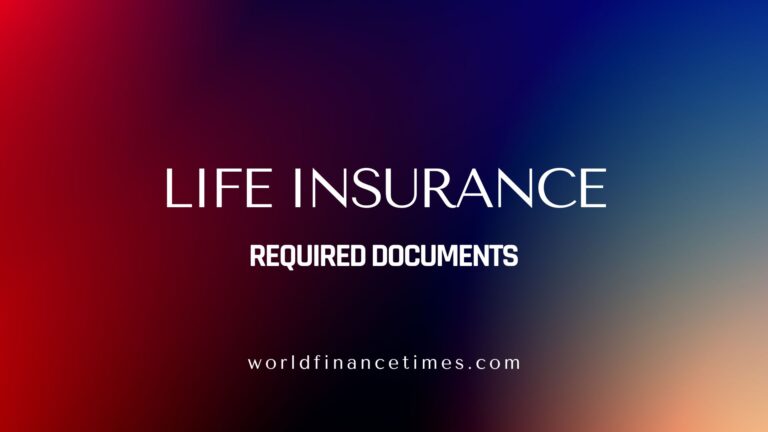
Navigating through the process of obtaining life insurance in the United States can often seem daunting. With numerous policies and requirements, understanding what documents are necessary is crucial for a smooth application and claim process. This comprehensive guide will walk you through the essential documents for both application and claim stages of life insurance, integrating key insights on term life insurance policies, whole life coverage, and universal life insurance, among others.
Also Read Pet Insurance Required Documents & Why Pet Insurance is important.
Life insurance serves as a cornerstone of financial planning, offering peace of mind and security for your loved ones. The right life insurance policy not only provides financial protection for families but also integrates with estate planning, offering tax benefits and investment opportunities. However, the journey begins with understanding the necessary paperwork. From personal information to medical history and beneficiary information, each document plays a pivotal role in the underwriting process and eventual policy management.
Life Insurance Required Documents
| Stage | Documents | Description | Notes |
|---|---|---|---|
| Application | Personal Information: | – Full name, date of birth, address, contact information, Social Security Number (SSN). | – May vary slightly depending on insurer. |
| Proof of Identity: | – Passport, driver’s license, state ID card. | – Must be government-issued. | |
| Proof of Age: | – Birth certificate, passport. | – Verifies applicant’s age for eligibility. | |
| Proof of Income: | – Pay stubs, tax returns, bank statements. | – May be required for higher coverage amounts or certain occupations. | |
| Medical History: | – Medical questionnaire, medical exams (depending on age, health, and coverage amount). | – Discloses existing health conditions that may affect policy cost and approval. | |
| Beneficiary Information: | – Full name, birth date, relationship to applicant. | – Designates individual(s) to receive death benefit. | |
| Policy Application Form: | – Filled out with desired coverage amount, riders, and payment details. | – Varies depending on insurer and policy type. | |
| Claim | Original Policy Document: | – Proof of active policy and coverage details. | – Essential for claim processing. |
| Death Certificate: | – Issued by local authority, stating cause of death. | – Verifies death and initiates claim process. | |
| Proof of Identity (Claimant): | – Passport, driver’s license, ID card. | – Verifies identity of person filing the claim. | |
| Beneficiary Information: | – Full name, date of birth, relationship to applicant. | – Ensures payment goes to the correct beneficiary. | |
| Additional Documents (depending on situation): | – Police report (accidental death), medical records (illness), military discharge papers (military service death). | – May be required to clarify circumstances of death. |
Application Essentials
Personal and Proof of Identity Documentation
When applying for life insurance, the first step involves gathering your personal information and proof of identity. Insurers will ask for your full name, date of birth, address, contact information, and Social Security Number (SSN). Acceptable forms of identity verification include your passport, driver’s license, or state ID card. These documents are fundamental in initiating the underwriting process, determining premium payment plans, and setting the foundation for your policy.
Financial and Medical Records
Proof of income is essential, with insurers typically requesting pay stubs, tax returns, and bank statements. This information helps in assessing your premium payment capabilities and in some cases, the cash value accumulation of certain policies.
Additionally, a detailed medical history is required. This may involve a medical questionnaire and possibly medical exams, depending on your age, health status, and the coverage amount you’re applying for. These steps are critical in determining the terms of your policy, including premium costs and any critical illness coverage.
Beneficiary and Policy Application Form
Choosing your beneficiary is a significant decision. You’ll need to provide their full name, birth date, and your relationship to them. This information is crucial for the proper designation of the death benefit claims.
Completing the policy application form with your desired coverage amount, any insurance riders and add-ons, and payment details is the final step in the application process. This form is your agreement with the insurer, outlining the terms of your coverage, including any policy renewal options or policy loan provisions.
Claim Documentation
Policy and Death Verification
In the unfortunate event of a claim, the original policy document and the death certificate of the insured are required. These documents prove the active policy and provide the coverage details, as well as officially verify the cause of death. This stage is crucial for the smooth processing of death benefit claims and ensuring financial protection for the beneficiaries.
Claimant Identity and Beneficiary Information
Similar to the application process, proof of identity for the claimant is required, alongside the detailed information of the beneficiary. These documents ensure that the death benefit is distributed correctly and according to the wishes of the deceased, respecting the beneficiary designations laid out in the policy.
Additional Documentation
Depending on the situation, additional documents may be necessary. For instance, a police report in the case of accidental death, medical records if the death was due to illness, or military discharge papers if applicable. These documents further substantiate the claim and assist in the determination of the payout.
Life insurance is a vital component of financial planning, ensuring that your loved ones are protected. Understanding the required documents for application and claim processes, along with the nuances of various policies, can empower you to make informed decisions. Whether considering term life insurance, whole life coverage, or exploring the benefits of universal life insurance, the right knowledge and preparation can streamline the process, ensuring you and your family’s financial security.